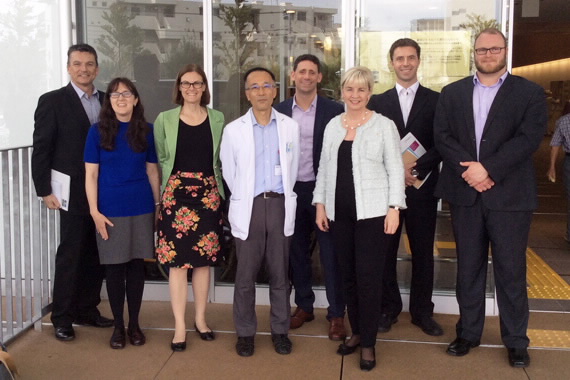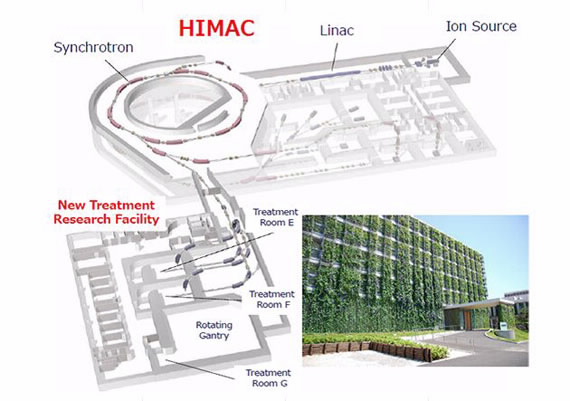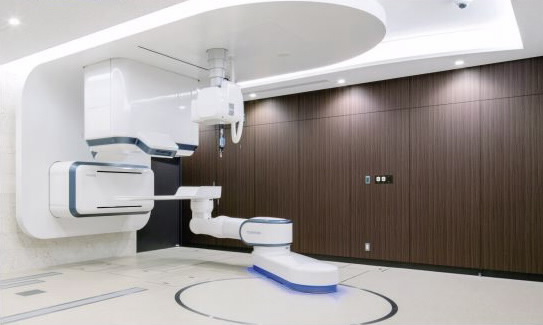 |
| (Left to right) Professor Rick Franich, Ms Michelle Durant, Associate Professor Verity Ahern, Dr Shinichi Minohara of I-ROCK), Dr Jonathan Sykes, Adjunct Professor Liz Kenny, Associate Research Professor Ivan Kempson and Dr Dale Prokopovich |
Australian researchers and clinicians have recently returned from Japan where they investigated the use of advanced radiation therapy for cancer using heavy ions at particle therapy facilities on a study tour coordinated by the Australian Institute of Nuclear Science and Engineering in association with ANSTO.
Japan has been using the techniques since 1994 and is considered a world leader in the field.
Australia now has an exciting commitment from the federal and South Australian government for a proton therapy facility in Adelaide-a critical first step towards providing this important treatment modality for Australians.
ANSTO is facilitating a national discussion on Australia's approach to particle therapy that also encompasses the emerging carbon ion- based techniques.
Many advanced nations (including Japan, Germany, Italy and Austria) also have carbon-ion particle therapy and international experience demonstrates that this can be both a cost effective and biologically effective shorter course of treatment for otherwise untreatable forms of cancer.
AINSE Managing Director, Michelle Durant, who speaks Japanese, and ANSTO physicist Dr Dale Prokopovich conducted the tour. Delegates from the medical and university sectors took part to gain first- hand knowledge of how Japanese researchers developed particle therapy from early experimental stages through to patient treatment in a hospital setting.

The first site visit was to the National Institute of Radiological Sciences (NIRS) in Chiba (pictured above), where major advances in the therapeutic applications, experimental research and new technological developments in particle therapy have taken place.
Participants took part in an in-depth technical tour of the Heavy Ion Medical Accelerator in Chiba (HIMAC). It provided the opportunity to gain insights from experts in the field on the functioning of the facility for research and the delivery of treatment to patients.
This visit demonstrated the benefits of particle therapy using carbon ions where a technique known as hypofractionation can effectively treat some cancers between 1-4 days.
It also included the opportunity to see a newly commissioned prototype carbon ion superconducting gantry which has reduced the size and cost of such a facility down to only slightly larger than a proton gantry, with further development anticipated to further reduce the size and weight for the next gantries.
Following the Chiba visit delegates returned to Tokyo for a networking session on particle therapy hosted by ANSTO physicist Dr Dale Prokopovich.
 |
| One of four treatment rooms at I-ROCK facility |
The following day the delegation travelled to the ion-beam Radiation Oncology Center in Kanagawa (i-ROCK) where delegates learned about the advanced application of particle therapy from both a technical and therapeutic standpoint.
The delegates were briefed on the process of a respiratory gated hypofractionated carbon ion treatment to a patient for a large liver tumour, where the entire course of treatment will be delivered to the patient over four days, and were able to follow the treatment process.
They also inspected behind the scenes to view the accelerator to see how a heavy ion particle therapy facility is physically incorporated into a hospital setting.
The final destination on the itinerary was to a new particle therapy facility in the center of Osaka, which is in the final stages of construction.
The participants spoke with the new facility operators and asked questions about how the construction phase might take place in an Australian context.
Leading Japanese specialists spoke about the proven track record of the approach and shared information on the most recent developments in implementation and treatment.
“At each location our participants had the opportunity to have an in-depth tour and meet with particle therapy experts,” said Michelle Durant.
“The tour provided a unique perspective of particle therapy you just can’t get reading about it or only seeing one aspect such as patient treatments. The participants were able to see the flow of technology from a research tool to becoming a fully operational treatment in a hospital environment as well as the exciting future developments that will make this cutting edge treatment even more effective” said Dale Prokopovich.
“It also broadened the networks of those who took part, connecting them with leading particle therapy researchers and clinicians.”
Because of the success of the excursion, expressions of interest are now open for another AINSE tour to Japan in 2018.
“An AINSE Particle Therapy Tour 2018 will have an agenda based on feedback from the 2017 participants,” said Durant.
Published: 17/10/2017


